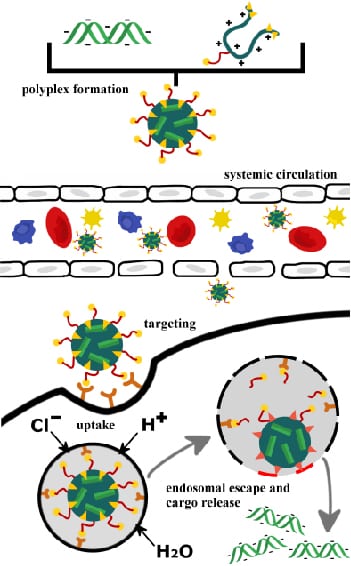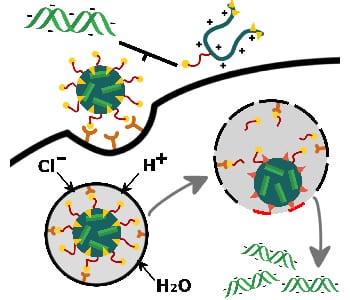Down regulation of gene expression promises exciting opportunities for medical applications by reducing the expression of defective or disease associated proteins. This knockdown can be achieved by small interfering RNA (siRNA) which, in a mechanism called RNA interference (RNAi), catalytically degrades complementary mRNA. This takes place in the cytosol of cells to where the siRNA needs to be delivered. On the way to their destination siRNA carriers face many barriers and challenges, which have to be kept in mind during carrier design. A highly promising class of carriers is cationic polymers who, due to their positive charge, can interact with the negatively charged siRNA, formating a polyplex. By using precisely designed oligoamino amides issues of polycations like toxicity, heterogeneity, and polydispersity can be addressed.
In their recent review in Macromolecular Bioscience Sören Reinhard and Ernst Wagner deal with the following challenges in siRNA delivery and how they can be overcome:
- extracellular stability by stable polyplex formation
- shielding to avoid rapid decay, clearance and unspecific interactions
- specific target cell binding and uptake through receptor-mediated endocytosis
- efficient endosomal escape
- release of the cargo in the cytosol
Extracellular stability can for example be achieved by bioreducible cross-linking, hydrophobic interactions or direct conjugation of the siRNA to the carrier. For specific cell targeting, besides the introduction of suitable targeting moieties, shielding needs to be considered to avoid unspecific cell uptake. Once the carriers are taken up by the desired cell, they are typically trapped in endosomes. Escape from the endosome can be facilitated by membrane disruption through endosomolytic peptide squences or other polycations. Finally the siRNA has to be released in the cytosol, which stands in contrast to the stability required outside of the cell. A fine balance of (in)stability, as well as stimuli responsive stabilization is required to achieve this goal. The last part of the review is devoted to in vivo applications, highlighting the progress made in siRNA delivery in animal models.
In recent years, much has been learned about the challenges in siRNA delivery. The precise structure of cationic oligoamino amides make them very well suited for the establishment of clear structure-property relationships which will accelerate the development of siRNA carriers towards broad clinical application.

















